How Important Is South Texas In The 2024 Election?
Exploring the swing in south Texas and what it means for Democrats in November.
In this series, we’ve been discussing the election data in some of the most populous counties. In this installment, we need to talk about South Texas. What should we expect from here in November? Are border counties actually moving right? What does the data tell us?
Since Democrats are gaining ground in almost everywhere in Texas except this region, I wanted to talk about it now, pull the bandaid off, and get it out of the way.
The Comptroller’s office determined this South Texas region is one of the twelve economic regions. It includes 28 counties and covers about 37,800 square miles. This area accounts for:
2.4 million Texans.
1.3 million registered voters.
7.02% of all Texas Democratic voters.
Here are the counties:
The anomalies.
When looking at the election data for the counties above, I found several anomalies. These issues are likely known to local activists and pollsters, and there are explanations for some, but they’re important to discuss.
McMullen County.
McMullen is a small county northeast of Webb County (on the border). It stood out because the Secretary of State lists 612 registered voters here, none of whom are on the suspense list, but the Census shows a population of 600 (hundreds of minors).
A report from the Texas Census Institute lists McMullen County as having an undercounted population. As many as 662 people likely live in this county, which would still show a disproportionate population to registered voters.
In 2020, there were 706 registered voters in McMullen County; 516 of them voted, giving the county one of the highest voter turnouts in the state, with a 73.09% turnout. It’s also one of the reddest counties in the state, with 89.15% of the vote in 2020 going to Donald Trump.
In 2017, McMullen County was named the wealthiest county in America but has been losing population since 2010. This anomaly is likely due to the census’ undercounting, but as of March 2024, there are more registered voters in McMullen County than the census says there are people.
Starr County.
Several counties in South Texas show huge disparities between the top-of-the-ticket and down-ballot. Perhaps this has something to do with the Trump effect in oil fields, but in counties like Starr County, there seems to be a heavy amount of ticket-splitting.
In 2020:
Trump received 47.06% of the vote.
John Cornyn received 39.62% of the vote.
Maybe Cornyn is unpopular in Starr County, but it wasn’t the only county.
Zapata County.
This one is interesting because Zapata County made national news when it allegedly flipped to red in the 2020 election.
In 2020:
Trump won 52.48% of the vote, turning Zapata red.
Cornyn lost with 43.06% of the vote, giving MJ Hager the win in Zapata.
The other counties with evidence of ticket-splitting.
Ticket-splitting doesn’t necessarily mean there was foul play. It’s interesting to see that ticket-splitting was not an issue anywhere else in Texas except for a handful of border counties.
Those other counties include:
Maverick
Zavala
We won’t know if this is a repeating pattern until after November. Still, the Democratic top of the ticket could be failing to do something regarding messaging to alienate voters. Hopefully, the Democratic Party in these counties will be aware of this and will work to fix it this election cycle.
What can we expect to see in the bigger South Texas Counties?
The bigger counties are those with over 200,000 population, Cameron, Hidalgo, Nueces, and Webb.
There has been a steady increase in turnout in these counties over the last several election cycles.
However, turnout in all of these counties remains low.
Of these four counties, Nueces is the only county that appears not to be making a rightward shift.
We’ve discussed Nuces County before. It’s almost a 50/50 county and has been for over a decade. Or, at least, it appears so. When you’ve historically had such low voter turnout, it’s hard to say if it would still be a 50/50 county if all registered voters made it to the polls.
In 2020, Hidalgo, Cameron, and Webb took a hard right. The jump was so huge that it makes us wonder if we will see a repeat in 2024 or if it was a one-time swing. Will Abbott’s Operation Lone Star change this by November? Or do Trump’s promises of mass deportation push voters in South Texas left?
Democrats received 295,000 from these four counties in 2020.
Overall, many “if” factors, including voter turnout and Trump’s fate, could change this trajectory.
The counties that seem to be hemorrhaging Democrats.
By hemorrhaging, let’s say, anywhere that moved +10 right or more in 2020. Brace yourself. (Remember, this is the only region where Democrats are not making gains.)
These hemorrhaging counties include Brooks, Duval, Edwards, Jim Hogg, Kenedy, LaSalle, Maverick, Starr, Zapata, and Zavala.
Except for Edwards and Kenedy Counties, all these counties have low turnouts.
There’s something I want to point out to you. Take Brooks County, for example:
In 2012, they had a 36% turnout, and 78% of the vote went blue.
In 2016, they had a 40% turnout, and 74% of the vote went blue.
In 2020, they had a 51% turnout, and 51% of the vote went blue.
So, are non-voters becoming voters and voting Republicans, or are more would-be Democrats staying home? With such a low turnout, it’s hard to say. Luckily, these ten counties only accounted for 28,000 votes in 2020, which can easily be made up in Harris County or DFW.
The remaining counties in this region.
These smaller counties only gave us 45,000 Democratic voters in 2020.
While these counties may appear to be moving to the right, once again, you must look at the turnout.
Again, the question is: Is South Texas moving right, or does it seem more like they haven’t been voting?
This region gave Democrats:
307,134 Democratic votes in 2012.
346,139 Democratic votes in 2016.
369,335 Democratic votes in 2020.
Despite the narrative that the Hispanic vote is moving right in South Texas, the prevalence of not voting is much higher in border counties than anywhere else.
While voter turnout has risen in these counties, that’s what’s most likely correlated with the Republican vote. There is no evidence that once Democrats are changing into Republicans as much as the data indicates that some non-voters are becoming Republicans.
Republican billionaires, specifically Harlan Crow, are spending a lot of money in South Texas to turn non-voters into Republican voters. While the evidence points to his money working as intended, it also points to an ongoing issue with non-voting.
Even if the overall percentages continue to move right in 2024, and we don’t know if they will, we could still see as many as 400,000 Democratic votes coming from South Texas and giving us a leg up in flipping the state.
The data from South Texas reminds us that elections are not won by chance but by the efforts of every voter.
No amount of money from Republican billionaires can overpower the people’s collective will—if that will is mobilized. However, to do that, the State Party must invest in infrastructure that supports Democratic values in South Texas. This means more outreach, better voter education, and a more substantial presence to ensure everyone who believes in a fairer, more just Texas knows their vote counts.
South Texas has the numbers to make a significant impact, but those numbers mean nothing if we don’t encourage and facilitate their participation in the democratic process. The path forward isn’t just about analyzing data; it’s about translating that analysis into action. It’s about building a resilient, inclusive movement that leaves no community behind.
Voting is the cornerstone of our democracy and how we ensure that our government truly reflects the will of the people. But for that to happen, we need to ensure that every Texan, from the largest cities to the smallest border towns, feels empowered to cast their ballot.
Vote early, vote often, just vote.
Leading up to the November election, we’re discussing the data in some of the most important counties in the upcoming elections. If you missed the previous installments:
October 7: Last day to register to vote.
October 21: First day to early vote.
October 25: Last day to apply for a mail-in ballot.
November 1: Last day to early vote.
November 5: Election day!
LoneStarLeft’s Newsletter is a reader-supported publication. To receive new posts and support my work, consider becoming a free or paid subscriber.
Follow me on Facebook, Twitter, TikTok, Threads, YouTube, and Instagram.

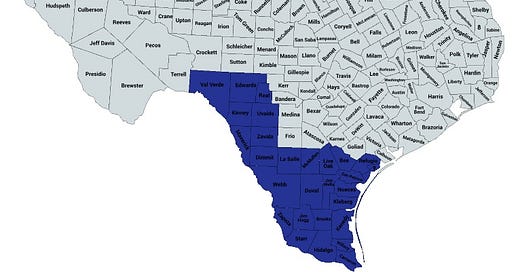



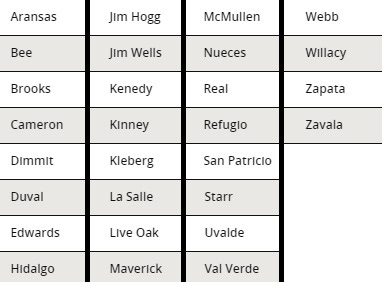




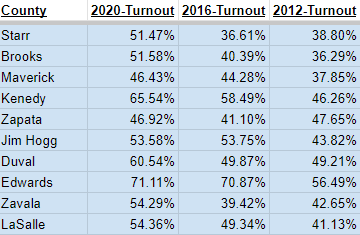
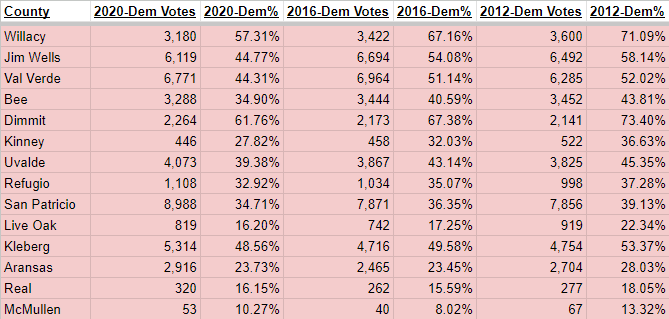
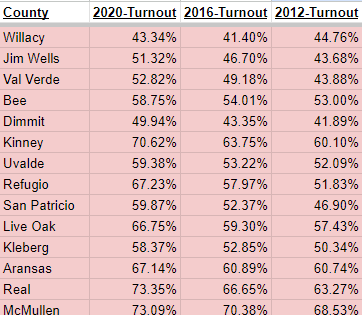
I suspect the county will turn Red or come really close to it. My colleagues don’t want to hear it. They get upset at me. They come up with things to say- that it’s just not true. I hope I’m wrong. But with such low voter turnout, the republicans will end up outvoting us.
There’s definitely a grassroots movement this cycle that is homegrown. There’s no Beto to move the masses. People kept waiting for someone to do something and were not realizing it was their responsibility. It’s an ingrained mindset. Take a look at Jim Wells, they are filling out rooms. Pat Macías, former chairwoman, came out of retirement to lead the fight. Zapata County has a new chairwoman, Diana Perez-Brandon and they have a giant Harris-Walz billboard. Hidalgo County has many new grassroots members and volunteers thanks to Mothers for Democracy RGV group. People from south Texas that live in the big cities are sending money down south to help turnout the vote. It’s happening.